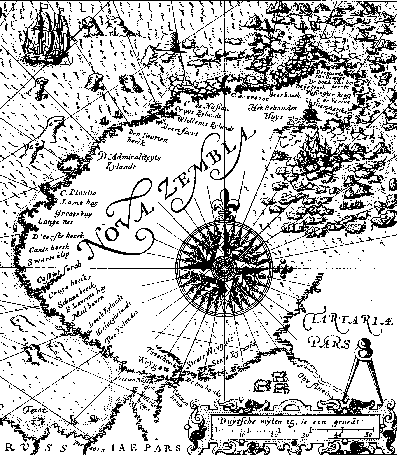 |
 |
 |
 |

Most of the searches for a Northeast Passage, though, were carried out by Russia, which hoped to increase the profitability of its fur trade by finding a more direct route from the Atlantic to the Pacific. By the end of the 16th century the Russians had established a commercial route via the Arctic to the fur-trading centre of Mangazeya on the Taz River in western Siberia. But a polar passage was still greatly desired. Several archaelogical digs in Taymyr in the 1940s provide evidence of an unsuccessful Russian mission to sail the Northeast Passage in or shortly after 1619.
By 1645, Russian trading vessels were routinely sailing between the Kolyma and Lena Rivers along the Arctic coast. In 1648, Semyon Dezhnyov, a Cossack, was the first European to sail what is now called the Bering Strait. He sailed east from the Kolyma toward the Anadyr basin, believed to be rich in furs. Although several of his ships were destroyed, Dezhnyov reached Cape Olyutorsky, from which he traveled overland to the north to the Anadyr.
Dezhnyov's voyage aroused interest in exploration in Russia. In the 1720s, Peter the Great authorized a number of voyages to the area he had first sailed. It was Vitus Bering, an officer of Danish birth who served in the Russian navy, who made the most important discoveries. In 1728 he discovered St. Lawrence Island and sailed through the Bering Strait (named for him) and well into the Arctic Ocean, although, because he did not see Alaska, he did not realize how far he had in fact sailed. Four years later, two Russians, Ivan Fyodorov and Mikhail Gvozdev, were the first Europeans to see Alaska.
The discovery of a passage to the Pacific led to the greatest operation in the history of polar exploration, the Great Northern Expedition, which began in 1733 and continued through 1743. Vitus Bering led the expeditions, carried out by nearly a thousand men, many of whom died from cold, scurvy, or other accidents. Such setbacks caused the Russian government to withdraw its support, but the mission was successful in producing sixty-two maps of the Arctic coast from Archangelsk to Cape Bolshoy Baranov. The only other Russian expedition in the next few decades was carried out by Nikita Shalaurov, a trader without government support, whose party was killed by the cold in 1764.
After Captain James Cook sailed from the Pacific north through the Bering Strait as far as Cape North (now Cape Shmidt), Catherine the Great renewed Russian interest in polar expeditions. Catherine hired Joseph Billings, a member of Cook's crew, to travel overland from St. Lawrence Bay to Nizhnekolymsk in the search for a gap between Chaun Bay and the Bering Strait. The gap was not discovered, however, until 1823, when Lieutenant Ferdinand Petrovich Wrangel successfully navigated and surveyed Kolyuchin Bay.
Navigators began searching in earnest for a water route from the Atlantic to the Pacific in the sixteenth century with Sir Martin Frobisher (1535-1594); subsequent explorers included John Davis, Henry Hudson (who in 1609 explored the New York river and Canadian bay that now bear his name), and William Baffin. In 1768, Samuel Hearne set out on a two-year walking expedition, which took him as far as the shore of the Arctic Ocean, but he found no passage.
With the end of the Napoleonic Wars in 1815, England, in an attempt to secure its naval superiority and the enormous commercial advantage that came with it, began what eventually became a decades-long endeavor to discover the Northwest passage. The Passage eluded explorers through Mary Shelley's lifetime; as late as 1845, Sir John Franklin set out on an expedition that ended in the loss of the entire expedition of 129 men. The Passage was discovered only in the 1850s by Sir Robert McClure, who led one of the forty search parties that sought information on Franklin's expedition. McClure's expedition was icebound for nearly two years, and was rescued by Captain Henry Kellett; Kellett's ship was in turn icebound for another year.
The Passage itself runs through the Arctic Islands of Canada some 500 miles north of the Arctic Circle, only 1,200 miles from the North Pole. The 900-mile east-west water route runs from Baffin Island to the Beaufort Sea through a field of thousands of icebergs, and thence into the Pacific through the Bering Strait, which separates Siberia from Alaska.
Even after the Passage was discovered, it took another half century for a single ship to sail through it: the Norwegian explorer Roald Amundsen made the passage between 1903 and 1906. Although the centuries-long search for the route was inspired by the desire for a more efficient trading route, the first successful commercial navigation came only in 1969, after the discovery of oil in Alaska.